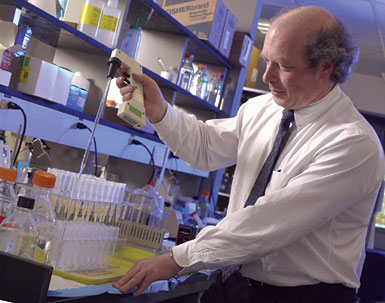Vital Signs
Simons elucidates mechanism of cellular "garbage disposal"
Cardiologist Michael Simons, M.D., has been tinkering with garbage disposals lately—not the kind in kitchen sinks, but the kind in human cells. He and a group of researchers—colleagues from Dartmouth, the University of Texas Health Science Center, and elsewhere—have discovered distinctive molecular mechanisms underlying the way certain compounds interact with proteasomes, known as the cellular garbage disposal system. Their findings, reported in the journal Biochemistry a few months ago, could ultimately lead to therapies for people with heart disease and cancer.
Each proteasome, a complex of enzymes with a cylinder-like core and a lid on its top and bottom, chews up proteins that a cell no longer needs. Proteasomes can be manipulated to slow or to accelerate the degradation of particular proteins, making them a potential target for therapeutic drugs.
Compounds: However, no one understood exactly how any of the therapeutic drugs or other compounds worked on proteasomes. Until now.
Simons, who is chief of cardiology and the director of DHMC's Angiogenesis Research Center, was investigating a growth factor known as PR39 (proline/arginine-rich peptide) when he discovered an unusual molecular process that enables it to be a proteasome inhibitor.
PR39 is an antibacterial peptide that stimulates angiogenesis— the growth of new blood vessels—in the myocardium, the middle layer of muscle in the heart wall. In addition, PR39 has been shown to inhibit inflammatory responses and to kill bacteria.
Most proteasome inhibitors link to an active site on the protein- digesting enzymes inside the cylinder. PR39, however, binds to the outside of the cylinder and forces the proteasome into a dumbbell-like shape, restricting the types of proteins it can ingest and destroy. The shape-changing effects are reversible, too, suggesting that potential treatment options would be controllable.
These findings also provide insights into how proteasomes function in general. PR39 appears to regulate how proteasomes interact with the proteins that are destined for obliteration. Proteasomes are known to change shape when they interact with an inhibitor, but "this is a very unusual shape change," says Simons. "It does not fit any known patterns."
Peptide: Now the researchers are detailing the functions of this naturally occurring peptide. It was originally isolated from pig intestines for use in healing wounds because of its multiple abilities—it can stimulate vessel growth, inhibit inflammatory responses, and kill bacteria. PR39 is an especially powerful agent for inducing vessel growth, and its angiogenic activity correlates with its ability to change the shape of proteasomes.

|
|
Michael Simons—the chief of cardiology
as well as a noted researcher—has
identified a molecular mechanism that
may have implications for the treatment
of both heart disease and cancer. |
One result is that it prevents the degradation of genes that activate several different angiogenic cascades. PR39 can also prevent the proteasome from destroying a certain molecule that inhibits a nuclear factor controlling cell growth and inflammation. And high levels of the molecule impede cell growth, which has implications for its use against cancers. Simons speculates that by changing peptide structure, the dual effects of stimulating and stopping growth can be separated.
"This is a new mechanism of action, a new class of inhibitors, and has interesting therapeutic implications," he concludes.
Laura Stephenson Carter
